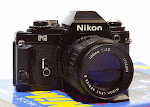I have talked about aperture and how we can use it to control depth of field, now it’s time to take a look at shutter speeds.
What is a shutter? The shutter is a mechanism, which allows light to reach the film or digital sensor for a precise length of time.
Today most cameras are equipped with a mechanical or electronic shutter, which allows user to select speeds at a fraction of a second.
Sample of shutter speeds:
1- second
½ - second
¼ - second
1/8 – second
1/15 – second
1/30 – second
1/60 – second
1/125 – second
1/250 – second
1/500 – second
1/1000 – second
1/2000 – second
1/4000 – second
If you look at the sample picture below of the shutter dial you will notice these speeds are marked as: 1, 2, 4, 8, 16, 30, 60, 125, 250, 500, 1000, 2000, and 4000.

The sample picture of the shutter speed dial is from an old Nikon FE2 film camera. On newer digital cameras these setting will be found on a LCD screen. The speed settings remain the same from film to digital.( 1/100 on a film camera is the same as 1/100 on a digital camera)
IMPORTANT:
Notice: as you move from one speed to the next fastest speed, you cut the exposure time in half.
Example: 1/500 allows light to reach the film or digital sensor for half the time allowed by 1/250.
This is the function of the shutter speed; to control the light reaching your film or sensor. The shorter the time the less light, if you cut the time in half you have cut the light in half.
I have already discussed how we can control the light by changing the aperture. As you should know: the larger the aperture the more light is admitted, the smaller the aperture the less light.
So what have we learned? There are two ways to control the light entering your camera: Shutter Speed & Aperture.
Shutter Speed Settings
When using the older film cameras in manual mode you will set the shutter speed manually and most likely be forced to use one of the specific speeds indicated on the dial or LCD screen. On many older film cameras you simply don’t have a choice of setting the speed other than what’s indicated on the dial or LCD screen. You cant set an intermediate shutter speed of say 1/556. You’re simply forced to stick with the numbers on the dial.
If your camera offers aperture-priority the camera will set the exact exposure. In this setting you set the aperture and your camera will set the exact shutter speed for proper exposure. In this way it is possible to achieve the 1/556 setting or any other fraction within the cameras limits. Ordinarily you cannot set these in-between settings.
Your camera may also have an additional setting: T (time), or B (bulb). These settings are designed to take longer exposures than the presetting offered on your camera. The bulb mode can be used for taking exposure from several seconds to hours.
With the “T” setting, you press the shutter release down to open the shutter. It stays open until you press the button again to close it. On some cameras you have to advance the film and cock the shutter for the next exposure.
With the “B” setting, you press the button down to open the shutter, which stays open as long as you hold the button down. When you release the button the shutter closes.
When using the “T” or “B” mode you will have to have your camera mounted on a tripod to reduce camera shake.
-------------------------------------------------------------------------------------

No comments:
Post a Comment